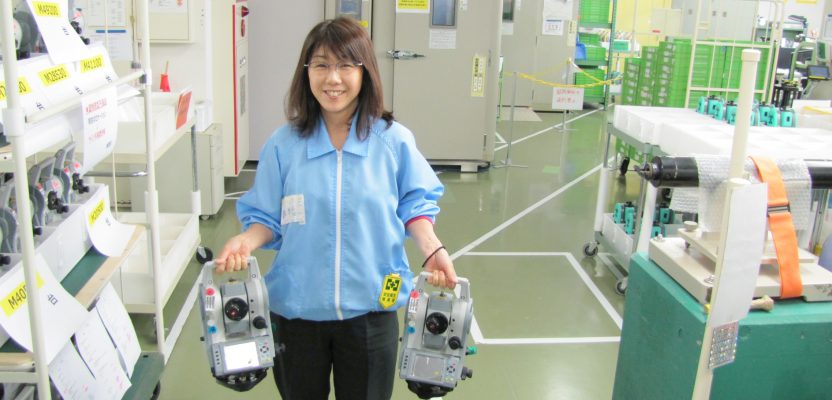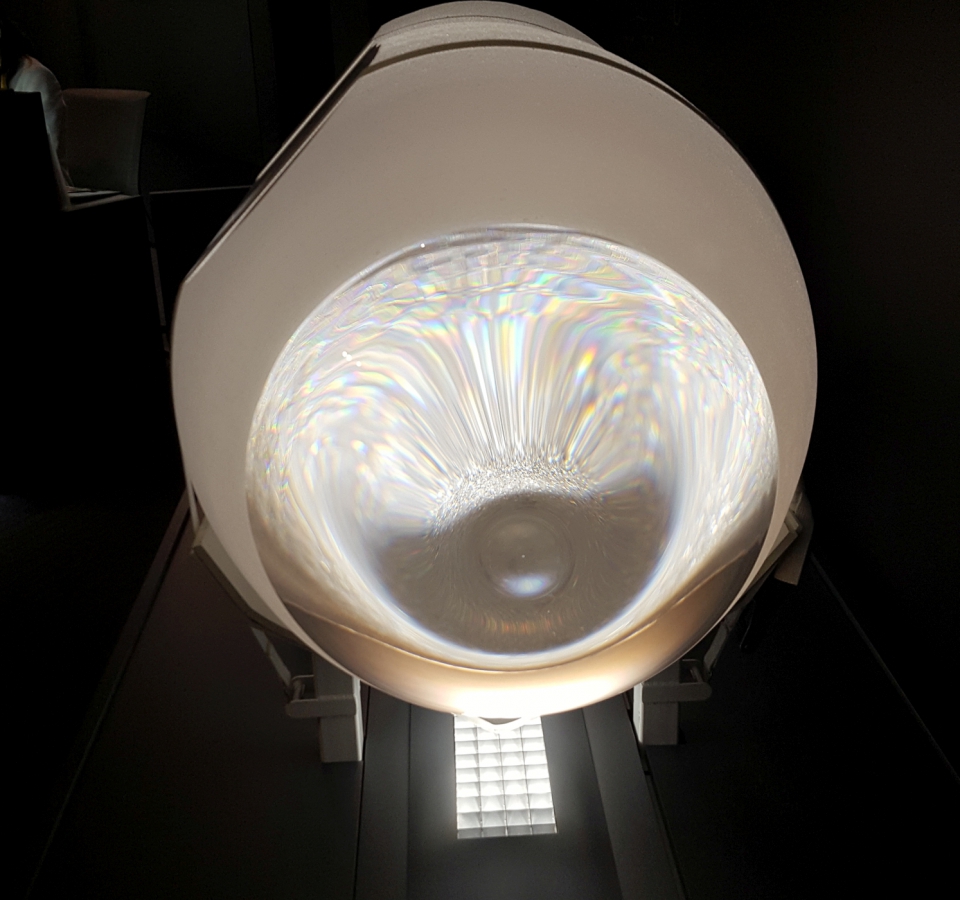xyHt visits Nikon’s optical surveying instrument production facility.
[Photo above: Mika Takeda, inspector at the Nikon-Trimble Zao Operation Center, demonstrates the light weight of the compact instruments Nikon is renowned for manufacturing. In the background: environmental chambers to temper and test components and instruments.]
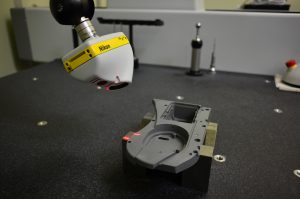
Nikon’s metrology laser checks a precisely manufactured housing component for a Nikon total station—to 1/1000th of a millimeter.
A massive stone table sits in an environmentally controlled room in the Nikon-Trimble Zao Operation Center in Zao, Japan. Mounted on a stable jig on the vibration-isolated stone metrology table is a finely machined housing component of what will become a surveyor’s total station.
On a dual axis gantry over the table, a small instrument the size of a deck of cards is mounted on a robotic indexing head; it casts a narrow swath of laser light, coursing back and forth over the housing. A nearby computer monitor tracks the progress as a 3D model of the part forms and is compared to the design model in real-time, to 1/1000th of a millimeter. The tiny laser scanner bears the familiar black and yellow markings of a Nikon product.
This is one step in the process that produces surveying instruments that are among the finest in the industry. I asked the technician if the parts tested in this manner are a sampling from the production line. No, he said, every machined part is checked.
While observing this operation, and during the rest of the tour of the factory, I pondered the fact that Nikon produces the machines that check their own machines. This underscores how Nikon’s culture of precision and “kaizen” (continual improvement) reaches far beyond their legendary optics—Nikon has broader reach than we realize. For example, computers at the facility contain integrated circuit (chips, like those produced by the “steppers” (semiconductor lithography systems) machines also manufactured there.
Many of the components of the bullet train I rode to the facility (about an hour north of Tokyo) had been checked with Nikon metrology tools, and Nikon surveying instruments were used in the rail system construction. Components from Nikon are also incorporated into multiple brands and models of surveying instruments. And I own a Nikon Coolpix camera.
All the endeavors and products of Nikon stem from the science of light; the history, legacy, and future of the company exemplify the “power of light.” This theme pervades the company philosophy, ethos, mission, and every line of business.
The theme of Nikon’s celebration of its centennial in 2017 was, “Unlock the future with the power of light.” While the world knows Nikon for their cameras and lenses, the light of this company shines much farther.
The theme of light is also foundational to the etymology of the name, “Nikon.” While this current company name, long associated with their camera line, was not adopted as the corporate name until 1988, the names Nikkor and Nippon Kgaku (see sidebar) share roots with the kanji characters of the famed city, Nikko, which literally translates as “sunlight.” While folks in the U.S. say “nye-kon,” the Japanese pronunciation sounds like “knee-con,” but with a shorter “ee” sound.
Another factor of “light” engrained in Nikon’s approach to surveying instruments is of “lightness.” We have all heard the business axiom of “faster, better, cheaper.” From their earliest instruments Nikon seems to have added “lighter, more compact, and efficient” to that mantra. One of the production team members at the Nikon-Trimble factory I visited demonstrated this by holding two total stations, one each with her index fingers.
Per requests from our readers and surveying colleagues for a closer look at Nikon, I finally made a pilgrimage to the Operation Center, in Zao, Japan. This facility is a striking example of a holistic culture of precision. These dedicated people perfect surveying instruments with the strength and resilience of the community this facility calls home.
The Ingot
Before travelling to Shiroishi Zao, I wanted to learn more about Nikon-Trimble as a company and was given a guided tour of the Nikon Museum at their headquarters in Tokyo.
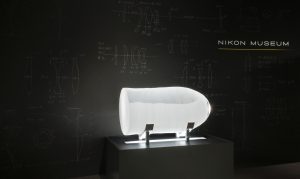
A one-ton glass ingot (secured with earthquake straps), used to produce photo-lithography lenses for Nikon, takes a month to pour; it’s on display at the Nikon Museum in Tokyo.
The first thing you see in the museum foyer is an enormous glass ingot. These and similar ingots are cut and then processed for optics for lasers, substrates, and lithography systems. This ingot weighs 850 kg (nearly a ton).
An ingot takes over a month to process by slowly feeding oxygen, hydrogen and silica compounds in a giant furnace at a temperature of nearly 2,000°C (3,700°F). From this ingot come the lenses for the stepper machines produced by Nikon (for integrated circuit manufacturing). While the lenses for surveying instruments do not come from this specific type of ingot, the processes and expertise are the same.
All the lines of Nikon’s business are on display—with a 100-foot-long wall as a display case of Nikon cameras alone—including dozens of surveying instruments. The Nikon Museum is open to the public; a recommended Tokyo stop for surveyors, photography buffs, and technology aficionados.
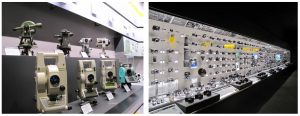
Displays at the Nikon Museum in Tokyo, Japan. Left: Surveying instruments since 1947. Right: Nikon cameras and Nikkor lenses. The same culture of precision in the manufacture of the famed Nikon cameras goes into Nikon’s surveying instruments.
Nikon-Trimble (NTJV)
The story of the Operation Center (factory) in Zao has recently taken a new path. The Nikon Trimble Joint Venture (NTJV) was formed in 2003. Takashi Tanzawa is the CEO, and the board members are from both companies.
Hiroshi Haruoka, NTJV’s manager for marketing in Nikon’s Building Construction Sales, said, “This is a joint venture, Trimble and Nikon, 50-50. This venture is focused on geospatial solutions, which includes surveying instruments, software, related R&D, and more.”
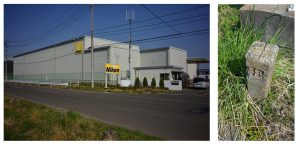
Left: The Nikon-Trimble Zao Operations Center in Shiroishi-Zao, Japan. Right: Of course a surveyor will look for survey control when traveling; a monument just outside the main gate was used as control for construction of the facilities.
NTJV markets Trimble products in Japan, and Trimble and Spectra have become global distributors of Nikon products. There is also joint R&D. For example, elements of the CAD functions of Trimble Business Center came from the NTJV software design team.
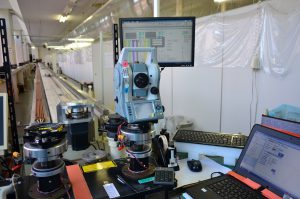
An instrument undergoes a series of tests on one of the interferometer tracks. It seems there are more testing and metrology steps than assembly steps.
It is, as Haruoka said, “a marriage of two cultures. Nikon’s optics, machining, manufacturing, software, and expertise, with that of Trimble, which includes GNSS, scanning, robotics—each benefit from the expertise of the other.”
This practice of tapping the expertise of others goes beyond that of major partners to include many smaller suppliers. Part of Japan’s manufacturing edge comes from the many thousands of very small producers, often tiny machine shops in small villages and even suburbs. Such small-component providers are tapped as makers of the perfect bolt, connector, micro motor, switch, etc.—and to stringent Nikon specifications.
In addition to final assembly, metrology, and testing, Nikon reserves some of the most critical engineering and manufacturing functions for their own factories.
The Central Axis
In addition to the all-important optical components of surveying instruments, one of the most critical to perfect is the central axis. Along with the inherent challenges of engineering a central axis that is as free from imperfections as possible, NTJV engineers smaller axes than those of the average total station—theirs are particularly compact and light-weight.
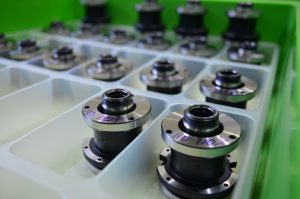
The small and light-weight central axis of Nikon instruments are a feat of complex and high-precision machining.
I was introduced to a technician who was inscribing tracking numbers on pairs of axis components for the central axis: a shaft and its companion sleeve. To eliminate what could be opposing stress patterns if these two components were machined separately, they are machined from the same metal blanks, which is not an easy machining task.
There are also thin sleeves of a material that looks like silicon tubes with dense patterns of holes. By using an original tool, dozens of tiny ball bearings are inserted into the holes. This is much more compact than standard bearing assemblies.
The general manager of the factory is Yoshizaku Narasawa. His career with Nikon began in 1974 with his first role in production control systems. He has been involved in the manufacture of surveying instruments since 1985. Narasawa has had training in the use of surveying instruments, as he notes, in the (very scenic) mountains nearby.
The factory floor, like the instruments produced there, is very compact, follows a carefully designed workflow, and is a picture of cleanliness and efficiency. Most of the manufacturing stations are in climate-controlled rooms with an emphasis on the elimination of dust and other contaminants. I was asked to don the distinctive light blue uniform, booties, and cap (which I was allowed to keep and proudly display in my office).
Clarity
I attended a demonstration of one of the digital microscope systems used to detect particles, micron-sized and smaller, on lenses and internal component surfaces. Atsuko Yoshida, manager of the planning and operations section (who also translated on the tour) added so much fascinating information about the production processes that I wish there were more room to include them all.
Yoshida explained that, for example, the central axis machining room must be kept at a steady 23°C (73.4°F), with limits on humidity and airborne particle (dust) thresholds. Though the instruments are designed to work in extremes of cold and heat, in highly humid and dusty sites it is critical that certain machining and assembly operations— especially for internal components—are performed in tightly controlled environments.
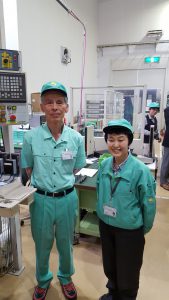
Left: The general manager of the factory, Yoshizaku Narasawa. Right: Atsuko Yoshida, manager of the planning and operations section who also translated during the visit.
Yoshida wears many hats. She is responsible for production scheduling, logistics, procurement, and order fulfillment. She confirmed that the demand for surveying instruments has grown steadily over the past decade, globally—but not just for robotic total stations.
While Nikon and other manufacturers cannot comment directly on sales numbers, what I observed while visiting Nikon supports the notion of a trend that mechanical total stations seem to be as popular as ever, and that production has pulled out all the stops to meet this rise in demand. Nikon, with its expertise and focus on compact, lightweight mechanical total station production, has definitely been (positively) impacted by this uptick in demand.
The Zao Operation Center, as Yoshida explained, is a combination of several factory lines, testing, production engineering, and distribution units. Another large section of the center produces “stepper” machines.
Nikon cameras and other products are manufactured at other facilities. There are shared metrology elements at Zao, but otherwise the different lines of business operate independently. While the different divisions of Nikon Corporation may operate mostly independently, there are elements of technological expertise, R&D, and the underlying science of light that touches each division. But mostly it is the Nikon culture that translates to the refinement and reputation of all products. Some of the same magic of the famed cameras is in each surveying instrument.
There is also a repair center in the NTJV section of the facility. The repair manager explained that all kinds of Trimble and Nikon surveying instruments are repaired there, mostly from the Japanese market: total stations, GNSS, scanners, construction instruments, and more. If the repair requires opening the instrument, a full cleaning and reassembly in a controlled environment is performed. The team handles all levels of repair; only on rare occasions are instruments sent to other facilities. They were bemused to find out that this visiting writer guy from the U.S. was a practicing “Sokuryōshi” (surveyor) and had several of the same types of instruments they repair in his inventory.
Kaizen
Sixteen years ago, Masayuki Takahashi, a local high school student from nearby Shiroishi City, was on a school tour of the Nikon Zao factory. He knew about the famous cameras and he enjoyed the tour. He hired on at Nikon immediately upon graduation. Initially he thought he might be making the famous cameras, but he found that producing surveying instruments was also very interesting and fulfilling work. Takahashi works in the machining section of the factory, mastering his craft through on-the-job -training, and has mastered a variety of machining functions.
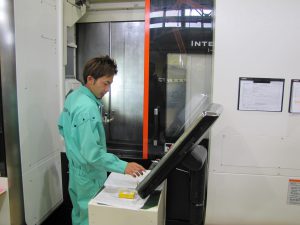
Masayuki Takahashi, who first visited the factory as part of a high school tour, now operates one of the advanced robotic milling machines.
I spoke to Takahashi at his current station, one of the large CNC robotic multi-axis milling machines. It is a robotic operation, but it takes a lot of experience and skill to assure proper operation; the operator must fully understand the principles, characteristics of the metal, and nuances of each step the machine takes. Operators are encouraged to study for national certifications, as Takahashi has. His supervisor at the next station, Katsuyuki Komuro (operating a recently added second large, similar CNC robotic multi-axis milling machine), holds over a dozen such certifications.
Takahashi says he enjoys the work and especially the “kaizen” aspect of the work: the way that the employees get together for constant and steady improvement. Nikon hires many of its Zao employees from the local community.
Narasawa noted that employees are happy and tend to stay there for a long time. Takahashi, who counts fitness and sports as his hobbies, appreciates the gym at the factory. I asked what he knew of the work that surveyors do with the instruments he helps produce. He said that sometimes, if they see a competitor’s instrument being used in the community, he is not so happy, but when he sees an instrument from the Zao factory he does feel a kinship.
There is a lot of company spirit in this facility. One particularly welcome element of Japanese factory culture that I enjoy greatly is staff cafeterias (something we see less and less of in the U.S.). I was treated to a splendid bento lunch with the managers and staff.
The culture of precision is evident at every assembly station. In the assembly and installation of components with lenses, operations are deftly handled by skilled workers at brightly lit, shrouded (for dust reduction) workstations. Instruments and components are put in environmental chambers to temper and to test in extremes of hot and cold, then put on a nearby tribrach, on a pillar with a view outside, to perform test observations to a distant target.
It seems there are more testing and metrology steps than assembly steps.
We’ve touched on Nikon metrology: Nikon makes precision machines that make sure precision machines are built right. This includes a broad portfolio: X-ray and computed tomograph, systems for shop floor inspections, handheld lasers, probes and cameras, non-contact systems, video measurement, industrial microscopes, semiconductor inspection, metrology software. The Nikon’s metrology division is very large and well represented in manufacturing worldwide. These tools are utilized broadly in their own manufacturing. This complete value chain leaves no wonder that their surveying equipment and components carry such high repute.
Auto-focus
One feature of the Nikon XF series total station is the auto-focus. An operator can eat up a lot of time focusing on each shot; this had been a universal curse that I, for one, have been bothered by for many years of total station use.
The Zao staff set up the instrument on the grounds of the factory and showed me how to operate it—that only took a few minutes. I had previously tried a total station by a different brand featuring auto-focus that had been on the market briefly, many years before, with mixed results. But this one worked very well despite my attempts to fool it.
The auto-focus uses the laser in the total station for ranging and then computes the focus settings. Smartphone cameras and standalone digital cameras use a pixel-based technology for auto-focus; they adjust the focus to maximize the contrast between adjacent pixels, which would indicate a sharp focus (but not always). This method would not be practical for total stations without camera features, and even when they do have built-in cameras, laser ranging would be more precise and efficient. Likewise, a laser-based auto-focus system for cameras would be impractical as it would be too complex, expensive, and perhaps more accurate than necessary.
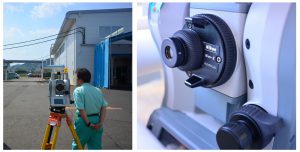
Nikon has developed a laser-based auto focus, now available on their XF and XS series total stations. I test drove the auto-focus at the factory on distant and near objects in varied light. It performed very well and so rapidly it was focused before I could get my eye behind the eye-piece.
The auto-focus on the Nikon XF has three modes to choose from. The first is a manual triggering of the auto-focus from the on-board keypad. The second is an automatic trigger only when there is a strong laser return from the distant object, as with a target or prism. The third is to have the auto-focus running in constant mode.
While the latter might use more battery life, the Nikon team told me that in their tests the difference was not dramatic. The difference would depend on how frequently one would take shots.
The crew at the factory offered the following insights, “In the case of ‘distance and angle measurement every 30 sec with 2-3 sec auto-focus movement’ we guess that the QG advance battery life would be less than around 15% according to our calculations. As you know, the battery life depends on the field and measurement conditions; therefore, we are afraid that we can’t ensure the above figure at an actual customer site.”
The range of the Nikon XF is 800m for reflectorless work, direct measurement being where the auto-focus would be of most use. I aimed at an ornate cornice on a temple across a field from the factory, and it focused before I had time to put my eye behind the lens, 460m away. I tried the manual triggering, which did not take any longer once I hit the key, and the strong-return option on some B&W paper targets the team placed on a fence. I found that it was even able to focus on returns from black plastic garbage bags, shiny metal, and windows (though not always, as would be expected).
I tried rapidly moving the scope around randomly to see how fast it would focus. One object high on an adjacent roof, once it focused and I looked though the scope, turned out to be the familiar dome of a Trimble reference station antenna. My conclusion is that for folks using mechanical total stations this could save a lot of time—plus any way to minimize handling and poking at an instrument that has been precisely leveled up on the tripod is a plus.
Fine Focus
Nikon Corporation has strengths that contribute to the solid reputation of all its products, including its own line of surveying instruments, but also to the high reputation of instruments of other companies that use Nikon-manufactured elements and metrology tools. In fact, there are elements from Nikon in several other lines of surveying instruments (though I understood when I was not given specifics as those are confidential matters).
Wayne Johnston, Trimble geospatial and optical market manager, has been involved in the NTJV for a decade. He also arranged and accompanied me on the Zao tour.
Johnston said, “We’re quite proud of this ongoing partnership and the trust that customers around the world place in these products. What started as a solution for a very specific audience, the Japanese surveyor, has evolved into a line-up of surveying instruments that build on the Nikon legacy of quality.”
I can appreciate that Nikon has chosen to focus on products and features for which it has proven to be a leader: superior optics, light, compact and ease of use. Nikon is not chasing a product portfolio that encompasses all surveying instrumentation, from the high-end robotic total stations, scanners, UAS, GNSS, etc. Likewise, it speaks well of their NTJV partner Trimble that it tapped the expertise of Nikon rather than trying to operate a complete value chain on their own.
I’ve also noticed that Nikon concentrates on perfecting what they do well and do not make big, splashy moves or create products simply for marketing buzz. They do what they do very well, and their reputation speaks for itself.
History: Nippon Kōgaku, Nikko, Nikkor, Nikon
Nikon celebrated its centennial in 2017. The Japan Optical Industries Corporation, or Nippon Kōgaku Kōgyō Kabushikigaisha, was formed in 1917. While many of its products were initially defense-focused, the first Nikkor camera lenses were released in 1927.
Post-WWII, the company sought to focus on more non-defense products and services; most recognizable is their camera and lens lines. An internationally acclaimed photographer of that era (and namesake for a Nikon-sponsored prize for photographic excellence) is Jun Miki. Miki’s works appear in museums worldwide; he, introduced Nikon cameras and Nikkor lenses to foreign photojournalists who were in Japan at the beginning of the Korean conflict. Word spread rapidly of these fine cameras and lenses; popularity among serious photographers and photography aficionados soared.
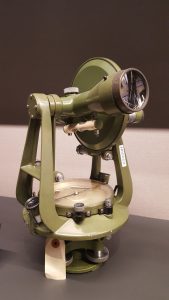
Transit “G,” introduced in 1947, was a departure from legacy surveying instrument form factors with lightweight materials, structure, and high-performance optics, and compact telescopes.
The company was also investing in other lines of products, and these grew to include surveying instrumentation. Nikon has over 90 years of experience producing surveying instruments; company records show the production of theodolites for military uses in 1927. The popular civilian line began in 1947 with the Transit G, which adopted the general appearance of transits like those from Gurley Precision Instruments, Inc. But already, the hallmark Nikon elements began to appear: the compact lenses, and lighter weight. The stylized structural elements carry curves for strength while reducing weight; the 1952 Transit H would complete this departure from surveying instrument legacy form factors.
The Transit H model gained popularity for revolutionary features such as incorporating all mechanical parts in a box-shaped body to improve dust-proof capabilities, being equipped with downsized (yet with no loss of capabilities) telescopes and light alloy metals for many parts. This model is considered by many as the base model, a template of sorts, for transits produced in Japan.
The 1967 NT2 Theodolite sought further to minimize scale reading errors and enhance efficient operations, which, like many theodolites, would have otherwise equated to high costs due to its complex structure. The NT2 was well received globally, praised for high precision at a reduced cost.
Nikon was not necessarily seeking a succession of “firsts” in the industry; instead they excelled in making compact, light, solid, and very precise instruments, focusing on reliability, rather than rapid rollouts. An example are their entries into the digitalization of surveying instruments, like the 1981 EDM ND250. I remember picking one up back then and immediately noting the contrast in weight (and ease of operation) to our other huge EDMs. It had a range of 2.5km (1.6 miles).
In 1985 they produced their first total station, the DTM1.
The name Nikon, which had previously been associated with their camera line, was officially adopted for the entire corporation in 1988, and this was about the time that Nikon’s surveying instruments became more commonly known and adopted by users worldwide. In 1989 they released the DTMA10LG, followed by the DTM-700 Series which had the CF program and data cards and later models connecting to onboard and external data controllers and software.
There has been a steady progression of models, to the present-day Nikon XF and XS series, Nivo C and M+ series, NPL-332+ series, theodolites, and auto-levels. Nikon has a strong presence in mechanical total station markets: instruments renowned for the clarity of their optics—nothing short of legendary—with high performance in low and bright light conditions and packing all these capabilities into lightweight instruments.
Their mechanical total stations are very popular in construction and engineering surveying markets, as are mechanical instruments in general, which comes as surprise considering the high profile of robotic total stations. Many surveying and construction practitioners prefer mechanical total stations, so much so in the recent decade of uptick in global infrastructure development that manufacturers like Nikon can barely keep up with demand.
The newest model is known in Japan as the Nivo-i. This integrates a digital camera with the optics and motorized functions for applications like concrete crack inspections (we will write more about this in the near future—it is quite cool), automated monitoring of construction features, landslide inspections, and more.
Another attribute of Nikon is to identify and perfect products; Nikon does not feel obliged to supplant successful products with new models simply for marketing purposes. If customers are happy, Nikon will heed their recommendations and continue to provide reliable and popular products.
Nowhere is this more evident than with levels. Their 1947 tilting level “E” had high performance but was far more compact than many other levels of the day. By 1959 the tilting level E5 had achieved such a reputation for simple operations and high reliability that this tilting level, with incremental improvements along the way, was sold for over 40 years.
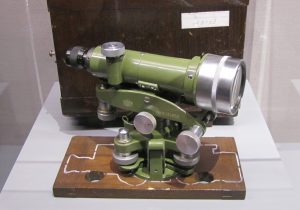
The 1947 Nikko “E” was early in a line-up of tilting and auto levels that gained a reputation for precision and reliability. Some models, with incremental improvements, would remain in production for three or more decades.
In 1970, their AE series auto level, with optical pass compensation, was an immediate hit and remained in production for 30 years. Tilt levels were marketed until 2000, their longevity due to the fact that vibration of construction sites would often befuddle early auto levels. (These issues have been mitigated in newer auto level models.) Among Nikon’s popular models of auto levels was the 1993 AE-7, with models like the AS-2C, AX-2S, AC-2S, and AP-8 released since.
In 2003 a key partnership in the form of the Nikon Trimble Joint Venture expanded the portfolio and marketing opportunities for both Nikon and Trimble.
Nikon is now a large corporation with many non-surveying lines of business: their camera line, of course, but also the manufacture of “stepper” machines for production of integrated circuits. Nikon is also a world leader in industrial metrology.
Tohoku Strong
The Nikon-Trimble Zao Operations Center is near Shiroishi City in Miyagi Prefecture, one of six prefectures that make up the Tohoku region in the northeast of Honshu, the largest of the islands of Japan. This region, while only a few hours north of Tokyo, is relatively placid, not as congested and not as heavily touristic as some other parts of Japan.
News of the devastating 2011 Tohoku earthquake and tsunami spread worldwide as so many areas of the region were damaged by the quakes and inundated by the tsunami.
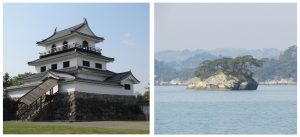
Left: Shiroishi Castle, near the factory, was the seat of a famed Samurai lord. Right: The nearby Matsushima Archipelago. Shiroishi Zao is in the Tohoku region of Japan, central to the earthquakes and devastating tsunami of 2011; the region and its people are renowned for their resilience, unity, and spirit in the post-disaster recovery.
Zao is directly inland from the offshore quake in the Pacific Ocean that triggered the events. While it’s far enough inland to not be directly affected by the tsunami, the earthquake did cause significant damage. The quakes and tsunami affected the region, friends, family, transportation, utilities, and more, but the region bounced back; an amazing sense of unity and purpose spread though the land.
Rebuilding and preparing for future such events revealed a tenacity, strength, and bonds among the people of the region. I saw evidence of this everywhere. The largest city in the region, Sendai, has since been successful in attracting new businesses, especially in the tech sector. The weekend of my visit, the City of Sendai held a massive parade though the center of town to honor a local hero, Yuzuru Hanyu, two-time Olympic gold medal skater.
At the factory, Yoshida showed me the distinctive orange earthquake restraining straps installed on objects, furniture, and machinery. She showed me photographs of some of the damage to the factory from the 2011 quake but noted that production resumed a mere ten days after the event.
There is a lot of pride in the region, in its history, and in businesses vital to the community, like Nikon. A castle stands near Zao, a vestige of the Date (pronounced dah-tay) Samurai clan of nearby Sendai. The Zao team took me there (and made me try on Samurai armor). I wish it were possible to acknowledge the many facets of hospitality extended by the Nikon team: the boat tour of the nearby Matsushima archipelago, shrine, temple, and castle visits, and the local cuisine. Make it a bucket list item to try the gyu-ton (beef tongue), local vegetables, and soba noodles.
Photo credits: Wayne Johnston and Gavin Schrock
Additional photos from the factory visit, the Nikon Museum, and the Shiroishi-Zao and Sendai area:

